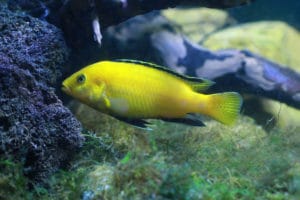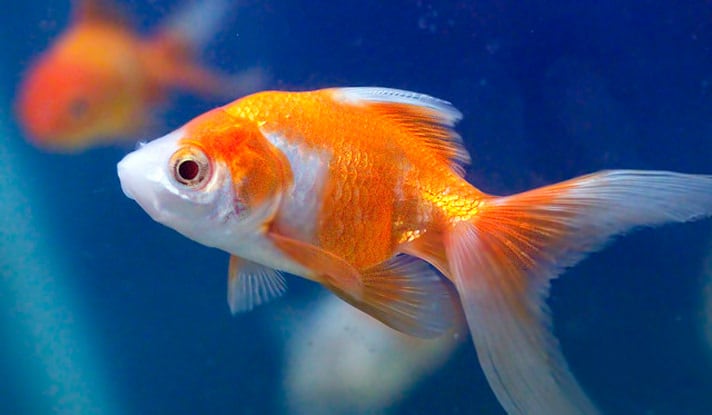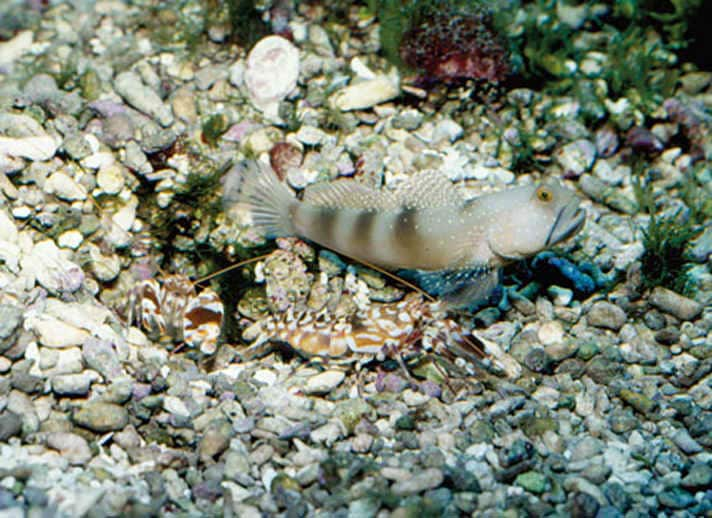Although nearly every species of fish is fascinating to me, I have a confession. I have a particular predilection for one family — the family Cichlidae, whose members are commonly referred to as cichlids. Their behaviors are varied and fascinating, and every species provides some type of parental care. In some species, it may be minimal, but in others it is downright unbelievable in its intensity and variation. In addition, the family contains many exotic and beautiful species.
There was a time that the cichlids of Lake Malawi could have been called “missionary cichlids,” because they recruited countless numbers of aquarists to the cichlid hobby. Yes, there was a time when cichlids were not popular in the aquarium world. This was both because they were generally too big for the typical fish aquarium and too aggressive and predatory toward tankmates. On top of all this, some species were not even colorful, and others were downright homely (if not hideous) in the eyes of the typical beginner. The family was mainly popular with the advanced aquarist, who was interested in the complicated behaviors of species in the family.
That all changed several decades ago with the importation of the cichlids of Lake Malawi. In those days, they were called Lake Nyasa cichlids, as the lake was then generally called Lake Nyasa around the world. But because “nyasa” merely means “lake” in the indigenous language, the fledgling nation of Malawi renamed the body of water Lake Malawi, and most of us followed suit. However, the nations of Mozambique and Tanzania still refer to the lake by its former name. Whatever it is called, this is the ninth largest lake in the world, and it is home to 850 endemic cichlid species (meaning these cichlids are found only in this lake).
The introduction of such dramatically colored fish was a real game changer for the aquarium hobby. Suddenly, cichlids were popular among more aquarists than just cichlid specialists. Not only were the fish colorful, but they were extremely active, swimming all over the tank. Many cichlid species that had come before were somewhat shy in captivity. These characteristics made these cichlids popular with people who would not have otherwise been drawn to cichlids.
The only problem with these fish species was that all were maternal mouthbrooders. There is much variation on a theme in this reproduction mode, but it made these fish less interesting to some of the old diehard cichlid enthusiasts. Because these cichlids are maternal mouthbrooders, there’s no complicated behavior, such as the parents herding the young and leading them to food, and providing them protection.
In any case, the cichlids of Lake Malawi are generally hardy, including the electric yellow. Although the water in the lake is hard and alkaline, these cichlids seem adaptable to water that is not quite so hard. If the water in your area is especially soft and acidic, it would be a good idea to invest in some rift lake salts. There are different formulations sold, but they all help raise the pH of the water and provide the mineral content to make the water chemistry more accommodating to these cichlids.
Introduction to the Hobby
The electric yellow (Labidochromis caeruleus) is a cichlid species found in the northern part of Lake Malawi on both shores. However, there is considerable color variation within the species. Some color forms are nearly white, with dark dorsal and anal fins, while others have a yellow spot on the cheek. There are many other color variations, as well.
The spectacular “electric yellow” variation is found between Charo and Lion’s Cove. This is a relatively small area on the northwestern side of the lake.
Pierre Brichard, famous for collecting fish in the Congo, introduced the electric yellow into the hobby. When civil strife in the Congo drove him to Lake Tanganyika, he became famous for his exports from there, and later, for his books on Lake Tanganyika fish species (mostly cichlids there, as well).
When he first introduced the electric yellow to the hobby, there was some confusion about the origin of the fish. The first shipments of this species came from Brichard’s collecting station on Lake Tanganyika and appeared on the market as Labidochromis tanganicae — a real puzzlement as the genus Labidochromis is endemic to Lake Malawi. Whether this was Brichard’s joke on the hobby and commercial industry is difficult to determine. There may have been some confusion along the supply line. Eventually the real location was discovered; the electric yellow was actually a color variation within a species — and not L. tanganicae, a bogus species, as it turns out.
Today, the electric yellow (or sometimes “yellow lab”) is enormously popular in aquariums all over the world. One of the authorities on African lake cichlids, Ad Konings, has speculated that more specimens exist in captivity than in the lake because the fish in the wild are found in a small locality, but captive specimens have been bred prolifically. Although specimens in the wild generally outshine those in captivity (perhaps because captive specimens have been inbred), captive electric yellows still look quite good.
Breeding in the Wild
All but one of the cichlid species from Lake Malawi are mouthbrooders; this species is also a maternal mouthbrooder. After laying the eggs, the female picks up the fertilized eggs and keeps them safely in her mouth for about three weeks until the fry are free-swimming. Some report that she feeds while mouthbrooding, but it has to be done very carefully as to not swallow the eggs or fry. In general, she does not feed at this time. The fry are ready to compete on their own when released, looking very much like minia-ture adults. Very little parental care is provided once they are released, though the mother may take all the fry back in her mouth if there is danger. As is typical in this mode of reproduction, the male has no interest in the female or her young after the spawning.
In the lake, the males dig pits in sandy areas (they are also reported to weakly guard a rock upon which females are invited to spawn, which probably reflects a certain versatility to habitats within the species). Females are then enticed to lay their eggs in the pit (or on the rock). After the male fertilizes the eggs, the female picks them up with her mouth while the male displays before her while releasing milt. A lot of that enters the female’s mouth, fertilizing more of the eggs. If the female does not leave immediately, the male drives her off. The male wants to attract more females, which betters his chances of passing on his genetic material — always the primary goal in the natural world.
Captive Breeding
To breed electric yellows in the aquarium, obtain three or four females to go with one male. Sexing this species is difficult — males and females look very much alike. The only clue is that the males tend to show more black coloration in the dorsal and pelvic fins. In my experience, sales personnel in local fish stores are usually able to distinguish the sexes.
The reason for getting so many females is that it has proved to be the best way to breed these cichlids. If you have only a pair, the male digs a pit and then begins to drive off the female if she doesn’t lay eggs. He either wants her to lay eggs or leave. With several females, his attentions are dispersed enough that eventually a female will actually be ready to lay her eggs. With only one female, the male will harass her so much that she often will not be able to feed.
Once the female is holding (carrying eggs), move her to another tank and let her incubate her eggs in peace. Some aquarists provide a partition in the tank with a hole for the female to enter and be out of sight of the male. More often, though, a holding female is simply netted out of the tank and transferred to another tank. She won’t drop her eggs during this procedure.
The furnishings in the tank should be very similar to those provided for the other Malawi species (even though rocks are hardly needed). Sand is necessary, so the electric yellows can dig. Also, provide rocks for some temporary refuge for the female.
There is another approach to breeding these fish. The strategy is to stock a tank with a large number of young electric yellows — at least 10 (and more is better) — and a lot of plastic pipes scattered along the bottom of the tank. Some aquarists even bundle the long pipes together in order to get more height in the aquarium. As a result, there are plenty of hiding places for females that are holding eggs or larvae. Some hobbyists utilize this method without using any sand or gravel, so apparently the fish are able to spawn without it.
Since there is always a ready market for this species, you may want to obtain the largest number of young by “stripping” the female of her eggs. This involves netting the female out and holding her with a wet hand in a wet net (dry hands touching the fish can damage its protective body slime) and tilting her face down toward a container to receive the eggs or fry. You can use a paper clip or a nut pick (normally used to pry out walnuts after the shell is cracked) to open the female’s mouth. Then gently shake her to get all the fry out. When finished with this procedure, return the female to the aquarium, where she will soon resume feeding. This method allows her to breed again sooner, so you get more fry in the long run. If you strip the female of eggs or fry, provide a clean container with a flow of water over the eggs or larvae. If you don’t, debris can settle upon them and become a source of a bacterial or fungus infection.
If you are interested in observing the natural behavior of the fish, just allow them to breed naturally in the aquarium. You won’t get as many fry, but you will get enough to keep a strain going. I prefer this method myself because I am interested in observing the natural behavior. Also, I am interested in keeping the species as close in behavior to their wild brethren as possible. If the females are stripped generation after generation, there is a good chance that the protective instincts of the mother may be lost, as there will be no selection for good parenting.
In the wild, parental females that swallow their eggs or fail to provide some protection for the young after the fry are released are less likely to have descendants, so such deviant behavior is selected out. With continuous stripping over the generations, the selective factor is not there, so it would be understandable if some females are not good parents. Because these fish are so commercially valuable, it is also understandable if there are only a few of us “purists” who want to raise our fish in the natural way.
Room and Board
Although in the wild these fish rarely exceed 3 inches, the abundance of nutrition they receive in the aquarium can result in specimens that eventually reach 5 inches. I have seen these animals kept in 25-gallon aquariums, but I would recommend a minimum of 50 gallons for a community tank.
These fish are much less aggressive than many of the Malawi cichlids, but the bigger the tank, the less aggression is evident. If you just want an attractive community tank, you can add tiger barbs and other reasonably large, fast-swimming species. Most aquarists get African cichlid fever, though, and want a tank that only includes cichlids from Lake Malawi. In that case, you can include peacocks (Aulonocara spp.) and other relatively peaceful cichlids. The name electric yellow was inspired by the name electric blue for Sciaenochromis fryeri, also from Lake Malawi, and they can be kept with electric yellows (but make sure you introduce the yellows first because they are the less aggressive of the two).
In any case, the electric yellow is a good Malawi cichlid to start with, and it may inspire you to keep other beauties from this lake. Consider that a warning. “Malawi madness” is a source of great learning and pleasure — but it can be costly in time and money. The good thing about these animals is that they are popular enough with the general public that they eventually pay their own way — via their fry, often making a profit for the owners.
Read More
Create a Lake Tanganyika Biotope Aquarium
Posted By: Chewy Editorial
Featured Image: Via Opayaza12/Shutterstock
Share:









